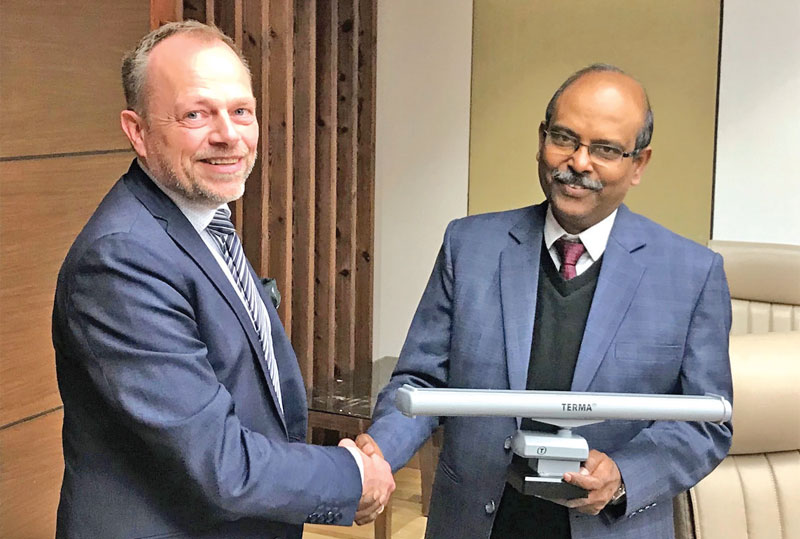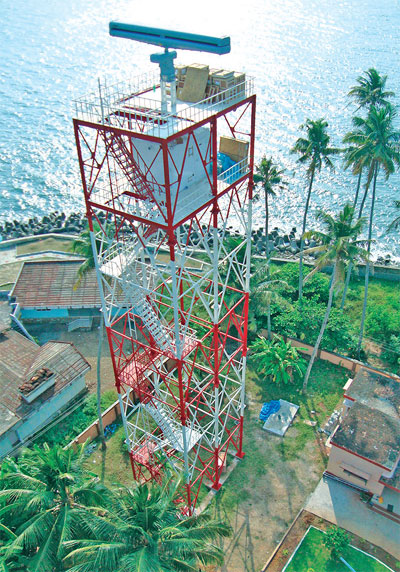BEL is nearing completion of Phase II of India’s Coastal Surveillance System
Atul Chandra
Bharat Electronics Limited is working to complete the 2nd phase of its Coastal Surveillance System (CSS) by 2023. Work is considerably advanced and the first part of Phase 2 of the programme is slated for completion next year, officials of the state-owned Defence Public Sector Undertaking (DPSU) told FORCE in May.

Lynenskjold with CMD, BEL M.V. Gowtama
The ministry of defence had concluded a Rs 1,814.32 crore contract with BEL in January 2020 for the ‘Chain of Static Sensors Project Phase-II’. The original contract completion date was November 2021, but this was delayed due to the COVID-19 pandemic. According to an MoD release, ‘post implementation of Phase-I and Phase-II of the chain of Static Sensors, the Indian coastline will be under the surveillance of 104 radar stations being one of the largest of such network’ (sic).
BEL is undertaking the installation of the CSS on behalf of the Indian Coast Guard (ICG) and has already established a network of 46 radar sites in Phase I of the programme which are now operational. According to the official, CSS Phase II will see the addition of 38 fixed sites and four mobile stations and will also cover the Andaman & Nicobar islands. India’s coastline is over 7,500km long and the CSS network will provide a much needed over-watch in several vulnerable areas of this long coastline. The chain of static sensors are installed all over the Indian coastline and are networked to present common operating picture at the command and control centres.
India’s existing electronic surveillance mechanisms are being augmented by provisioning of an electronic/ radar chain called Coastal Surveillance Network (CSN) comprising of Chain of Static Sensors having radar, Automatic Identification System (AIS), Long Range Identification and Tracking (LRIT), day/ night cameras, communication systems. The information obtained from these sensors will aid in the development of Maritime Domain Awareness (MDA) for which 51 Indian Navy and Indian Coast Guard stations have already been interconnected providing a Common Operational Picture. Vessel Traffic Management System (VTMS) radars in ports will also facilitate surveillance of port areas.

BEL is also upgrading equipment in CSS Phase II, including the decision support systems and also indigenising sensors such as the Electro-Optical (EO) systems. All the required systems and components for CSS Phase II have been procured, company officials said. The complete decision support system and software for CSS has been indigenously developed by BEL. The decision support system and software developed by BEL for the CSS programme has also been exported to friendly nations such as Sri Lanka, Mauritius and Maldives. The entire CSS programme is being handled by BEL’s Bengaluru Complex. BEL has also been contracted by the ICG to provide maintenance and support for the equipment supplied by it for the CSS programme. The company has already placed personnel at all sites for maintenance.
“Surveillance radars are key components of the CSS programme. BEL is producing these radars in India under a Transfer of Technology (ToT) agreement with Terma. BEL has already produced 46 Terma Scanter 2001 radars under license from Terma for CSS Phase I and is now manufacturing an additional 38 of the same for CSS Phase II. Most of the modules/ spares etc. will be made by BEL and its vendors in India and the complete installation/ commissioning and life cycle support of the radars are also going to be undertaken by BEL,” said Anupam Mathur, vice president & general manager, Terma Asia Pacific.

